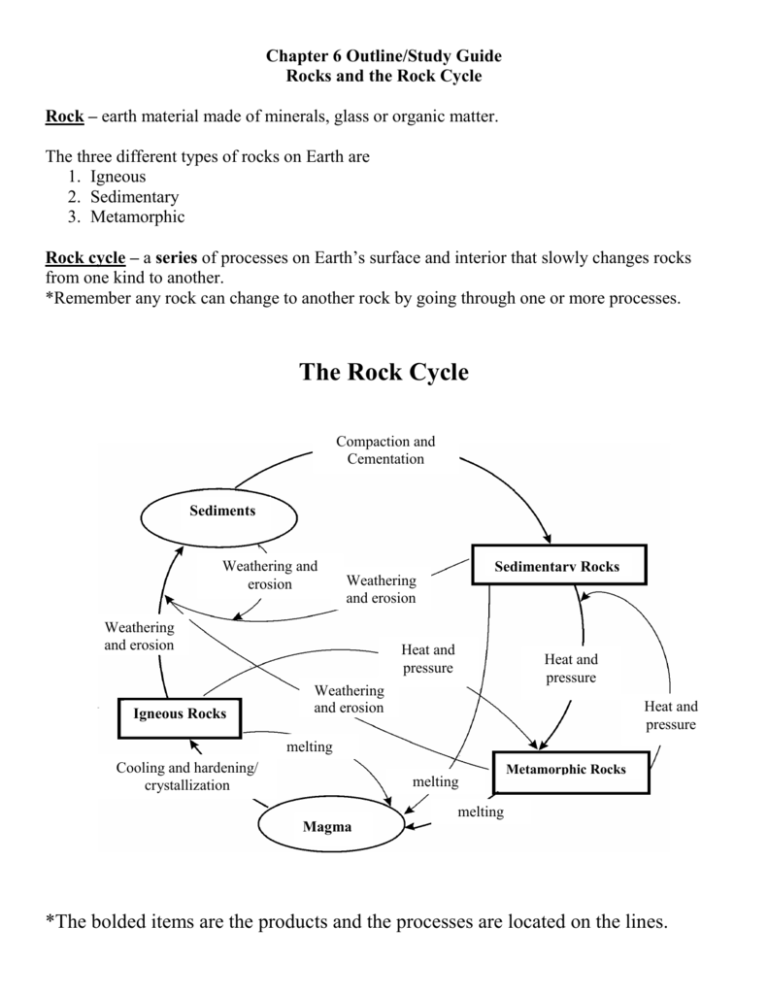Chapter 5
advertisement

Chapter 6 Outline/Study Guide Rocks and the Rock Cycle Rock – earth material made of minerals, glass or organic matter. The three different types of rocks on Earth are 1. Igneous 2. Sedimentary 3. Metamorphic Rock cycle – a series of processes on Earth’s surface and interior that slowly changes rocks from one kind to another. *Remember any rock can change to another rock by going through one or more processes. The Rock Cycle Compaction and Cementation Sediments Weathering and erosion Sedimentary Rocks Weathering and erosion Weathering and erosion Igneous Rocks Heat and pressure Heat and pressure Weathering and erosion Heat and pressure melting Cooling and hardening/ crystallization melting Metamorphic Rocks melting Magma *The bolded items are the products and the processes are located on the lines. Igneous Rocks (examples – gabbro, obsidian and granite) Igneous rocks form when magma or lava cools and hardens. There are intrusive and extrusive igneous rocks. Intrusive – igneous rocks that form below Earth’s surface (plutonic) - coarse-grained (grains are large enough to be seen with your eye) - all intrusive rocks contain minerals Extrusive – igneous rocks that form on Earth’s surface and cool as lava (volcanic) - fine-grained (grains are too small to be seen with your eye) Mafic 1. dark-colored 2. rich in iron and magnesium 3. low silica content 4. magma is thin and fluid Felsic 1. light-colored 2. rich in silicon and oxygen 3. high silica content 4. magma is thick and slow-flowing If an igneous rock has a porphyritic texture it has two distinctly different textures because there were two stages of cooling – slow and then fast. Vesicular texture- this happens when the magma has gases in it causing the rock to form holes when it cools. Sedimentary Rocks (examples- breccia, coal, shale and rock salt (halite)) Sedimentary rocks form when sediments become pressed or cemented together (compaction and cementation) Sediments – loose materials such as rock fragments and mineral grains that have been transported by wind, water or glacier. Weathering – the breaking of rocks into smaller pieces, either mechanically or chemically. Erosion – the process that moves weathered rocks from one location to another. Deposition – the build up of sediments on the bottoms of lakes, valleys and the ocean floor usually in layers. Compaction – when layers of sediment become compressed by the weight of layers above them. Cementation – when sediments are glued together by minerals deposited between the sediments. The three types of sedimentary rocks are clastic, chemical and organic 1. clastic – made up of broken fragments of plants, animals and primarily other rocks. - The formation of a clastic rocks begins when water breaks, moves and relocates rock. - conglomerate – made of rounded, pebble-sized fragments that are held together by cement. - breccia – made of angular pebble-sized fragments that are held together by cement. - Sandstone- made of small mineral grains (usually quartz) that are cemented together. - Shale – made of flaky clay particles that compress into flat layers. 2. chemical sedimentary rocks – made from minerals precipitated from a solution or are left behind when a solution evaporates. (example – halite (rock salt)) 3. organic – made from the remains of once living things. (examples – limestone, chalk, coal, ) Fossils can be found in sedimentary rocks. Metamorphic Rocks (examples – gneiss, slate, schist, quartzite and marble) Metamorphic rocks form from existing rocks when the temperature or pressure changes. The two textures of metamorphic rocks are foliated and nonfoliated. Foliated – when mineral grains flatten and line up in parallel bands. Nonfoliated – when mineral grains change, grow, and rearrange but do not form bands. Local metamorphism – metamorphism that affects a small volume of rocks. Regional metamorphism – metamorphism that affects thousands of cubic kilometers of rock.





